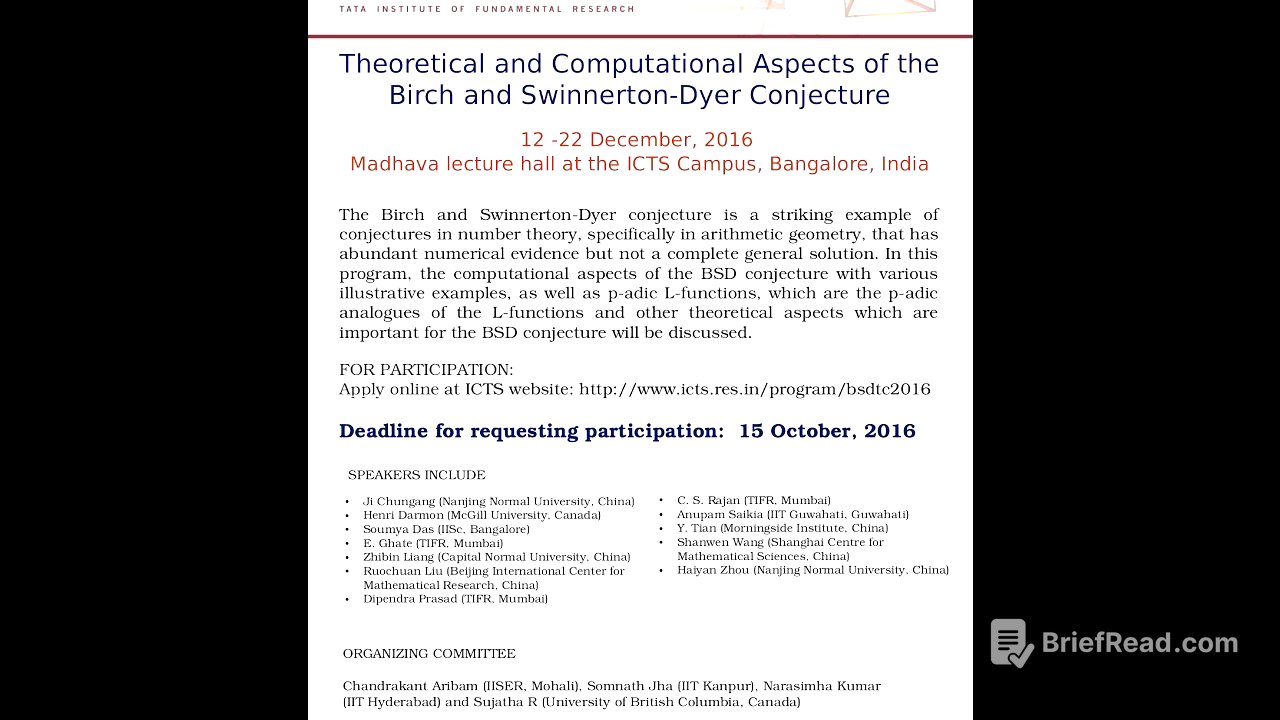TLDR;
This video introduces the Birch and Swinnerton-Dyer (BSD) Conjecture, a central problem in number theory linking the algebraic properties of elliptic curves to their analytic behavior. The lecture outlines the conjecture's genesis, emphasizing its theoretical and computational aspects. It highlights the importance of understanding elliptic curves, L-functions, and the interplay between algebra and analysis in this field.
- Elliptic curves are studied over various fields, each introducing new aspects.
- The BSD Conjecture posits a deep connection between algebraic and analytic invariants of elliptic curves.
- Computational verification plays a crucial role in understanding the conjecture.
Introduction to elliptic curves and BSD Conjecture [0:11]
The lecture begins by thanking the organizers and welcoming participants to the conference on the Birch and Swinnerton-Dyer Conjecture. It mentions a previous workshop in Beijing in 2014 that covered the conjecture's statement and theoretical aspects. The current conference aims to involve more Indian students and researchers, providing them with access to the subject matter. Participants are encouraged to review available notes and interact with speakers to understand the intricate pieces of the conjecture. The speaker emphasizes that the conjecture's beauty lies in how its small pieces fit together perfectly, a mystery that drives both theoretical and computational research.
Elliptic curves [5:31]
The speaker introduces elliptic curves as the central object of study for the BSD Conjecture. Elliptic curves can be viewed algebraically, topologically, or analytically, but for the conjecture, they are best understood as homogeneous equations in three-dimensional projective space. The general form of the equation is presented, and the coefficients can be in rational numbers, integers, complex numbers, real numbers, or p-adic fields. The focus is on studying the solutions of these equations in projective space, using homogeneous coordinates. The speaker draws an analogy to stereographic projection to explain dehomogenization, where one part of the equation is examined without losing significant information.
Theorem 1 [18:58]
The lecture transitions to a key theorem regarding the structure of elliptic curves. For an elliptic curve E over a field K, the set of solutions E(K) has the structure of an abelian group. This means that given two points in the solution set, a third point can be manufactured, and even from one point, another solution can be derived. This is not generally possible for any equation, making elliptic curves particularly interesting. The abelian group structure implies the existence of a binary operation, allowing for the addition of points.
Why does this work? [23:22]
The speaker explains the geometric basis for the abelian group structure on an elliptic curve. Given two points on the curve, a straight line is drawn through them. Since the elliptic curve has homogeneous degree 3 and the line has degree 1, the line intersects the curve at a third point. This third point is then used to define the addition of the original two points. The process involves coordinate geometry, finding the equation of the line, and determining the intersection points with the elliptic curve.
Simple case [28:11]
The lecture discusses a simple case where the field K is the complex numbers. In this context, an elliptic curve is a genus one curve, topologically equivalent to a torus. The solutions over an elliptic curve relate to a lattice, and the elliptic curve can be thought of as C Mod Lambda, where Lambda is a lattice in the complex numbers. The speaker explains how identifying points in the lattice leads to the formation of a torus.
Number fields [32:26]
The discussion shifts to elliptic curves over number fields, which are finite extensions of Q. Examples of number fields include Q adjoined with the square root of two or Q adjoined with i. Studying elliptic curves over number fields is particularly interesting from a number-theoretic perspective.
Theorem 2 [33:29]
The speaker presents the Mordell-Weil Theorem: for a number field K and an elliptic curve E over K, the solutions E(K) form a finitely generated abelian group. This is a significant result that allows for the application of structure theory for finitely generated abelian groups. The structure theorem implies that E(K) is isomorphic to a free part (copies of Z) and a torsion part.
Algebraic invariant (or Modell-weil) [35:53]
The algebraic rank, denoted as r, is defined as the invariant coming from the structure of E(K). It represents the number of free copies of Z in the group structure. The speaker notes that the rank can change when considering extensions of the base field, leading to questions about the bounds on the rank. The computational aspect of determining the rank of an elliptic curve is also highlighted.
Simple case [42:51]
The lecture transitions to the analytic side of the BSD Conjecture, contrasting it with the algebraic approach. The analytic side involves constructing something completely analytic in nature, motivated by the Riemann zeta function. The speaker emphasizes that this construction is not ad hoc but has a method behind it.
The speaker uses the simple case of k equals Q to explain the analytic side. Q sits inside the real numbers as a dense subset. There are more metrics that you can define on Q, the simplest one being the absolute metric. When you complete with respect to that metric you get the real numbers. You can also use another metric which actually for every Prime p i can define a metric which I'll denote by VP absolute value with respect to P. With respect to this metric a point in Q is close to zero if it is divisible by a very very high power of P. When you complete it with respect to the metric then you get a field QP which is called the pic local field.
Conjecture [58:45]
The speaker states that the L function has an analytic continuation and is a very deep theorem. The analytic L function is the other side of the bird wi and dire conjecture that I was referring to. You have a function in a complex variable power Series so therefore you can talk of the order of Vanishing of that power series that's called the analytic rank.
Conjecture 2 [1:01:10]
The lecture concludes with the weak form of the BSD Conjecture: for a number field K and an elliptic curve E defined over K, the order of the L-function at s=1 equals the algebraic rank of the elliptic curve. The speaker notes that the stronger form of the conjecture gives an exact formula for the leading term of the L-function.
Q&A [1:03:26]
The final section addresses questions from the audience, clarifying the relationship between points at infinity, the action of the Galois group, and the role of invariant factors in determining the structure of abelian groups. The speaker also discusses the connection between elliptic curves and modular forms, as well as the use of Iwasawa Theory to attack the BSD Conjecture.









